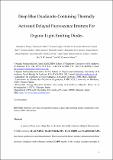Deep blue oxadiazole-containing thermally activated delayed fluorescence emitters for organic light-emitting diodes
Date
07/09/2018Author
Grant ID
EP/P010482/1
EP/P010482/1
EP/J01771X/1
703387
Keywords
Metadata
Show full item recordAbstract
A series of four novel deep blue to sky blue thermally activated delayed fluorescence (TADF) emitters (2CzdOXDMe, 2CzdOXD4MeOPh, 2CzdOXDPh and 2CzdOXD4CF3Ph) have been synthesized and characterized. These oxadiazole-based emitters demonstrated bluer emission compared with reference emitter 2CzPN thanks to the weaker acceptor strength of oxadiazole moieties. In particular, the oxadiazole compounds doped in hosts (mCP and PPT) emitted from 435-474 nm with photoluminescence quantum yields ranging from 14%-55%. The emitters possess relatively large singlet-triplet excited state energy gaps (ΔEST) from 0.25-0.46 eV resulting in long lifetimes of the delayed components ranging from 4.8 to 25.8 ms. Electroluminescent devices using these oxadiazole emitters as dopant emitters gave emission maxima (λEL) from 446 nm to 474 nm with maximum external quantum efficiencies ranging from 4.2-11.2%.
Citation
Wong , M Y , Krotkus , S , Copley , G , Li , W , Murawski , C , Hall , D , Hedley , G , Jaricot , M , Cordes , D B , Slawin , A M Z , Olivier , Y , Beljonne , D , Muccioli , L , Moral , M , Sancho-García , J C , Gather , M C , Samuel , I D W & Zysman-Colman , E 2018 , ' Deep blue oxadiazole-containing thermally activated delayed fluorescence emitters for organic light-emitting diodes ' , ACS Applied Materials & Interfaces , vol. In press . https://doi.org/10.1021/acsami.8b11136
Publication
ACS Applied Materials & Interfaces
Status
Peer reviewed
ISSN
1944-8244Type
Journal article
Description
EZ-C thanks the University of St Andrews for support. The authors are grateful to the EPSRC for financial support (grants EP/P010482/1, EP/J01771X and EP/J00916). IDWS is a Royal Society Wolfson Research Merit Award Holder. CM acknowledges funding by the European Commission through a Marie Skłodowska Curie Individual Fellowship (No. 703387).Collections
Items in the St Andrews Research Repository are protected by copyright, with all rights reserved, unless otherwise indicated.

